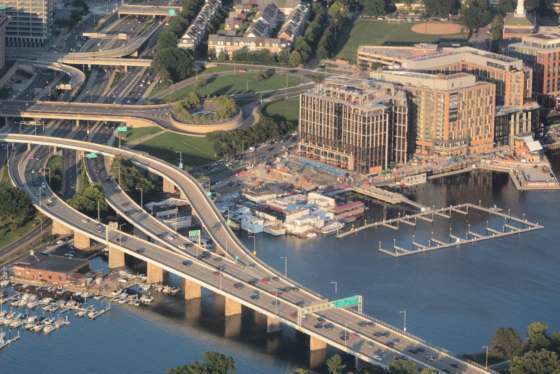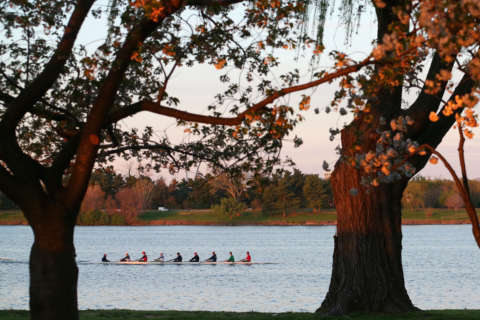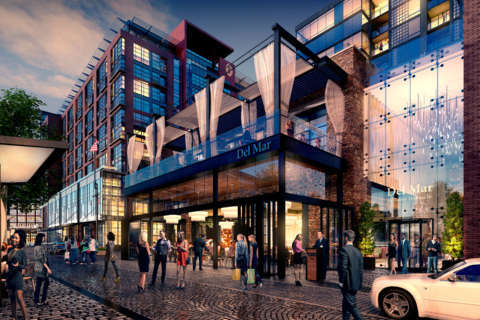Editor’s Note: This article is part of a five-part series on D.C.’s new Southwest Waterfront development, The Wharf.
WASHINGTON — On a rainy Tuesday morning in late August, a work crew near a new development along the Southwest Waterfront blocked one lane on Maine Avenue SW during the morning rush hour.
The work zone immediately produced a 4-mile long traffic jam that rippled backward on Interstate 395, across the 14th Street Bridge.
The bottleneck showed that when a flood of residents, office-workers and visitors travel to the 24-acre project, known as District Wharf, starting next month, it won’t take much more than a double-parked car or fender-bender to cause travel headaches.
If developers have it their way, in one month, the grand opening of The Wharf will coax droves of walkers, bikers and drivers to what they hope will be the city’s premier spot for waterfront dining and entertainment.
Neighbors of the massive redevelopment are leery of the looming congestion, but there are plenty of ways to reach The Wharf that don’t involve a car. WTOP takes a look at the transportation changes afoot along the Waterfront.
Congestion concerns
Southwest D.C. is rapidly becoming a destination for locals and long-distance drivers. And it’s not just The Wharf. New condominiums have opened around the Waterfront Station and Audi Field on nearby Buzzard Point will be the new home of DC United bringing more visitors to the city’s smallest quadrant.
“I think it’s great, I welcome the changes. Traffic has always been a problem. And when you do the upgrades, you have to take the good with the bad,” resident Ray Galvez said.
Galvez has lived in Southwest Washington on and off for 50 years. Many Southwest residents like Galvez are optimistic about the new retail options and park space and less concerned about traffic.
“Traffic will be a problem, especially when you combine it with the soccer field and the Nats games. But in my mind, it all gets wiped out because we’re going to have so many more options here,” said Barbie Halstead, who has heard from a few locals concerned about traffic on the small stretch of Maine Avenue under the Southwest Freeway.
The freeway carries more than 176,000 vehicles over Washington Channel every day. In comparison, about 13,000 vehicles drive down Maine Avenue near the Waterfront daily, according to recent traffic counts. That number is expected to increase when The Wharf opens for business. An estimated 12 to 15 million people are expected to work, live and visit The Wharf annually.
“During The Wharf’s opening week activities, DDOT will use traffic control officers and message boards along Maine Avenue to advise motorists of congestion. Message boards will also be activated on nearby freeways,” said Terry Owens, spokesman for the D.C. Department of Transportation.
DDOT is also formulating a Traffic Operations and Parking Plan to support crowds headed to future large events at the new destination, Owens said.
“It’s hard enough on a weekend to get past the Fish Market, so compound that exponentially and you do have potential for — in that section — real traffic congestion. In my mind, it still pays off. I’m excited to be able to have the music venues, the restaurants, and access to the river,” Halstead said.
A pedestrian haven

A few footsteps from the traditional urban streetscape of Maine Avenue, the thoroughfares take on a different texture. Belgian block cobblestones and smoother pavers comprise The Wharf’s alleys, side streets and promenade, not asphalt.
“We are really trying to create the most walkable environment possible … by actually going to something called shared-streets where the priority is given to people walking, not those driving,” said Stan Eckstut, principal of Perkins Eastman Architects.
Eckstut said the concept was inspired by many pedestrian-friendly corridors in European cities. The streets will in some ways resemble the cobblestone alleyways in parts of Georgetown, but without speed bumps.
“There’s no curbs, there’s no crosswalks, there’s no traffic lights, there’s no stop signs. The pedestrian enters and they can go any direction they wish,” Eckstut said.
Planners like Eckstut expect the subtle variations in road surface and narrower passageways will naturally slow down drivers. With Maine Avenue bearing the brunt of the through traffic, drivers who do end up meandering through The Wharf are expected to instinctively slow down and drive more cautiously.
“Cars are everywhere. Of course we don’t want to eliminate auto-convenience. That is very much a part of our working environment, it’s our culture and it’s also how buildings get serviced. But we are really trying to have the walking person dominating the scene,” Eckstut said.
Getting there
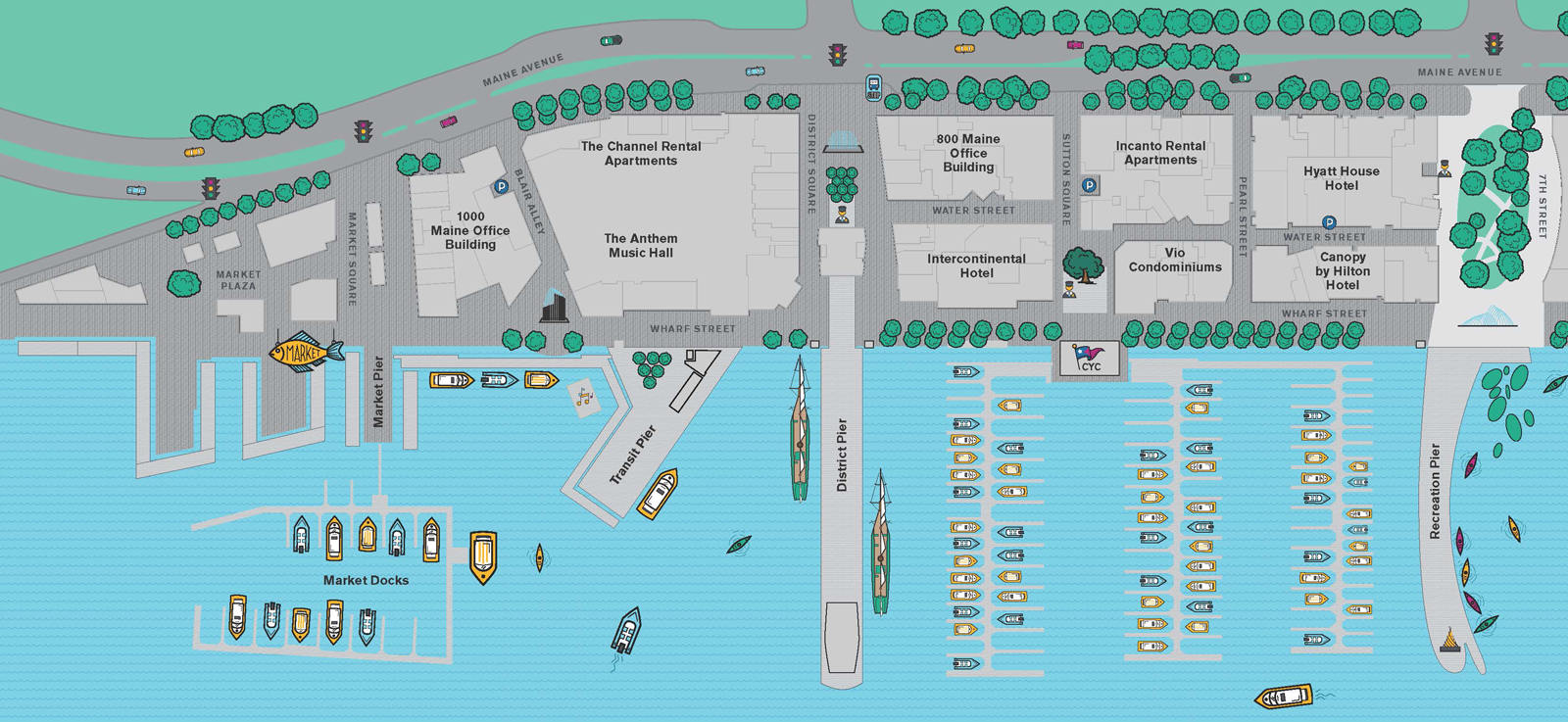
Maine Avenue SW will be the main driving route that leads toward the new neighborhood. According to DDOT, the road will remain a four-lane boulevard with curbside parking. A cycle track is planned on the southern side of Maine Avenue to give bicyclists an easier way to travel between the Tidal Basin and Navy Yard.
According to the project designs, the median strip is intended to serve as a placeholder should the city elect to build a streetcar line down Maine Avenue in the future. However, the District has no plans to do so in the near future and is focused on extending the existing line in Northeast DC.
“DDOT is working closely with The Wharf developers PN Hoffman and Madison Marquette to aid this major project on the Southwest Waterfront, and mitigate impacts to the traveling public on Maine Avenue. The range of measures being taken includes new signage and new roadway striping, new traffic signals, roadway resurfacing and new bus options,” said DDOT’s Owens.
The development’s two-story parking garage is located underneath the development. A portion of the garage is already open to the public and is accessible off Maine Avenue near the Fish Market.
The entrance is located along one of The Wharf’s cobblestone streets, Blair Alley. The other entrance will be accessible off Maine Avenue between 7th and 9th streets at Sutton Square as the grand opening nears.
Parking rates are:
- Early Bird (in by 8 a.m.): $12
- 0 to 1 hour: $10
- 1 to 2 hours: $17
- 2 to 3 hours: $22
- 3 or more hours: $25
It costs $2 to park for the first hour with parking validation at the Fish Market.
The Wharf’s underground parking offers about 1,500 spaces in addition to curbside parking along Maine Avenue.
Other transportation options
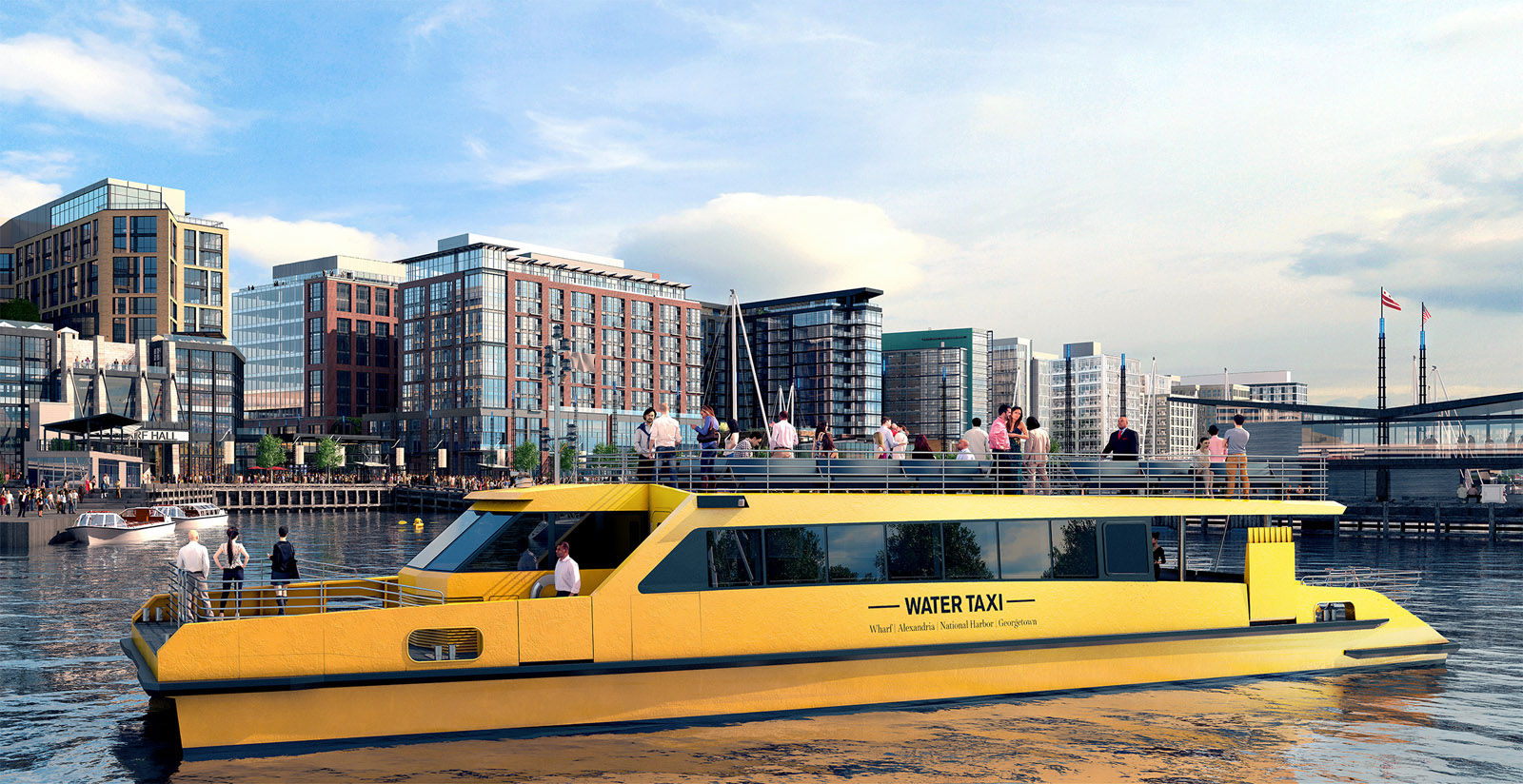
L’Enfant Plaza and Waterfront on the Green Line are the nearest Metro stations to The Wharf. From Waterfront Station, The Wharf is an easy, and mostly flat, 10-minute walk down M Street to Maine Avenue.
The W9, 74, P6 and V1 Metrobus routes also run near the Waterfront.
Cyclists from the L’Enfant Promenade, Tidal Basin and the Anacostia Riverwalk will have easy access to the condos, shops and outdoor venues when a planned cycle track is added along Maine Avenue. Several Capital BikeShare corrals are slated to be installed at The Wharf by October.
The developers are also working closely with the National Park Service and National Capital Planning Commission to construct a staircase to link Benjamin Banneker Park to Maine Avenue. The staircase on the west side of the grassy park area will bring pedestrians to the sidewalks and crosswalks near from the Fish Market.
The Potomac Riverboat Company also plans to add a stop at The Wharf’s new transit pier.
Read more of WTOP’s coverage:
Part 1: DC’s most ambitious redevelopment project set to open
Part 2: Examining The Wharf’s environmental impact
Part 3: Restaurants, retail and entertainment venues take center stage
Part 5: Maine Avenue Fish Market gets a makeover

